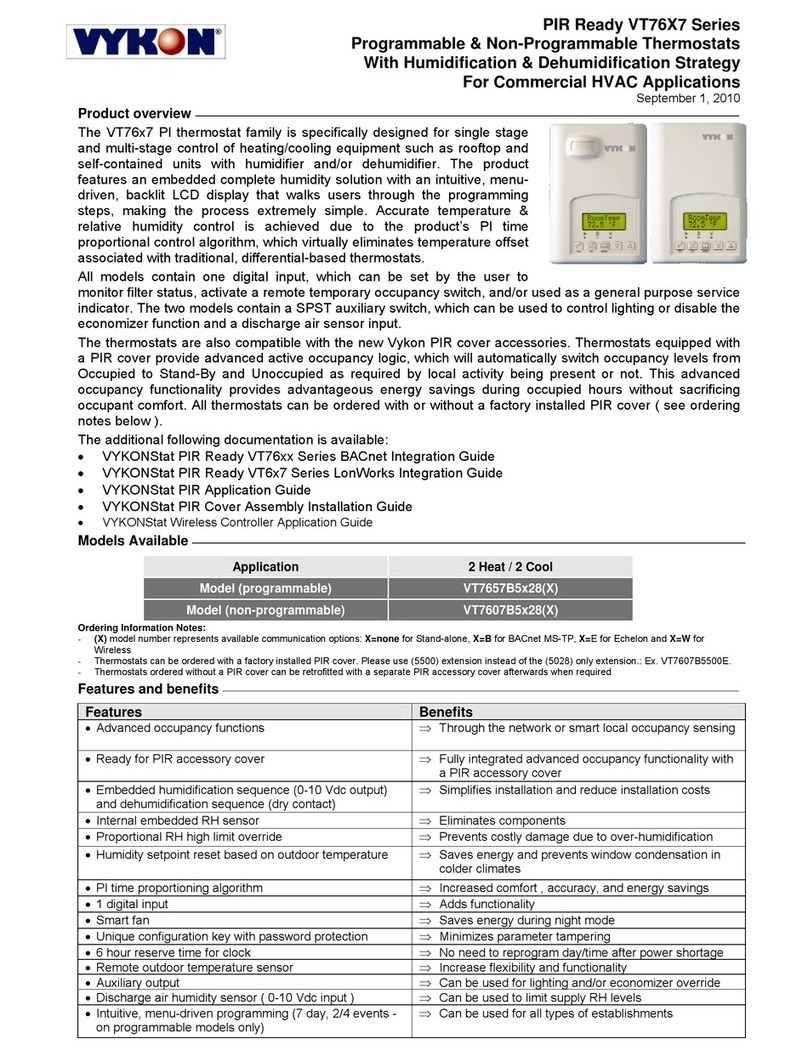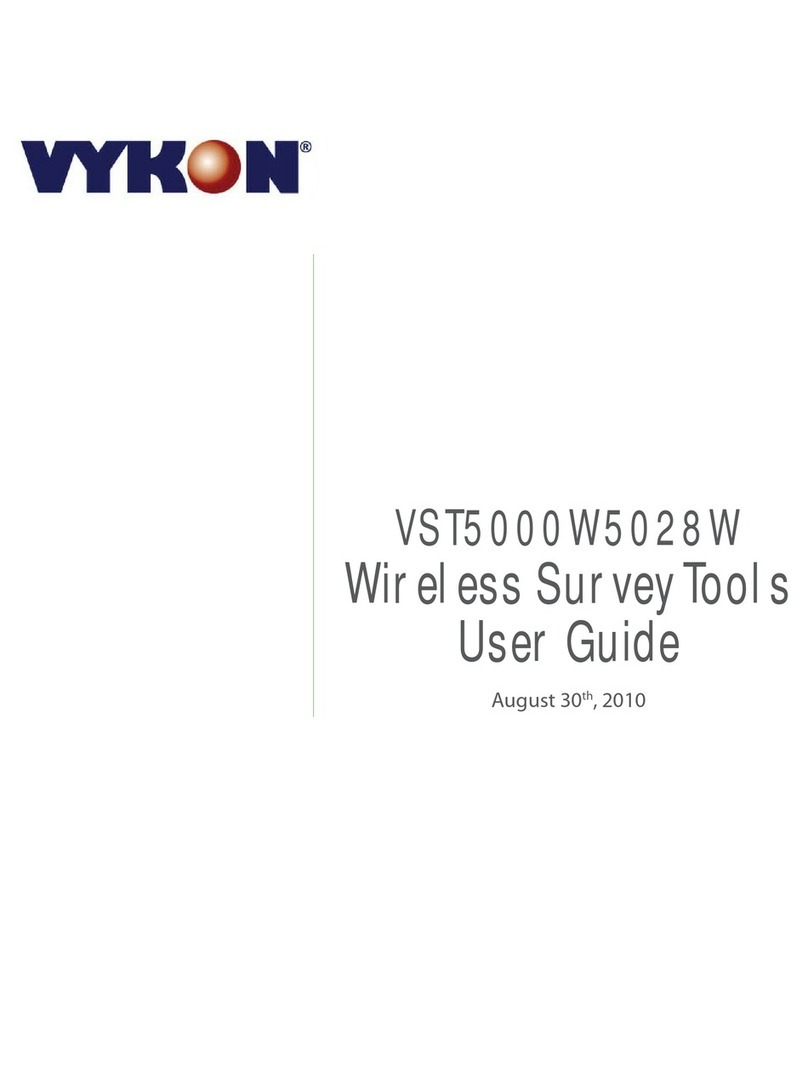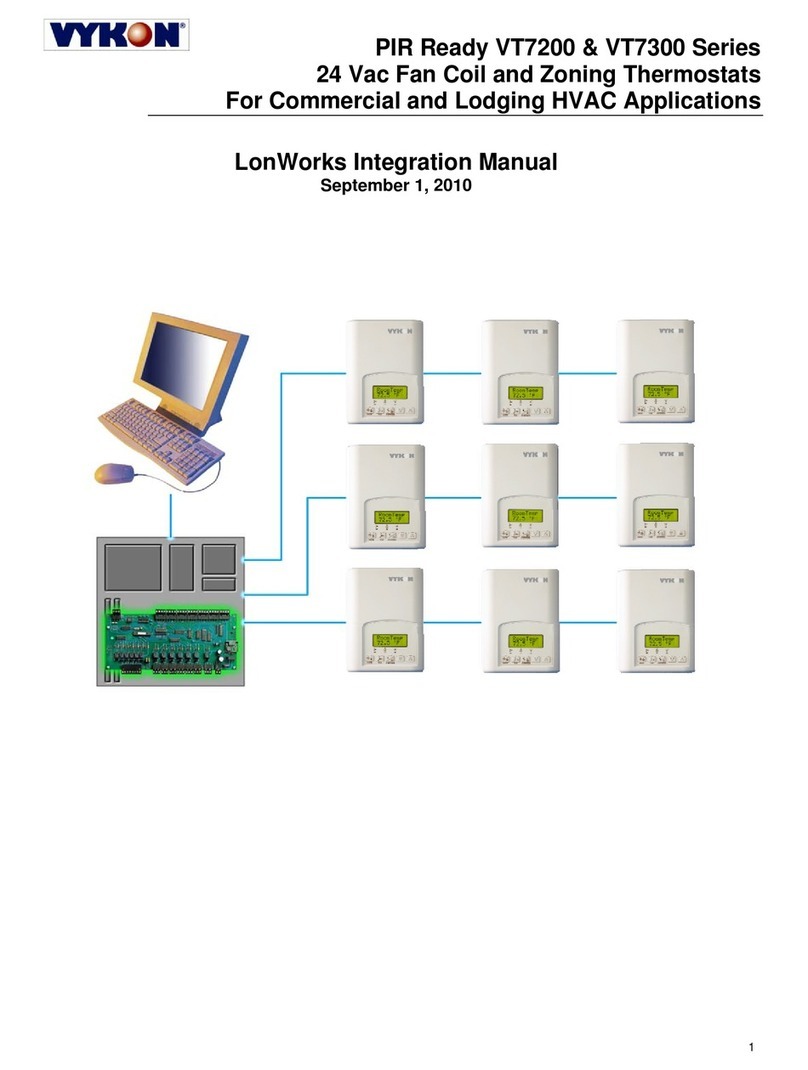
3
Theory of operation
The VT7600 uses a Vykon proprietary adaptive logic
algorithm to control the space temperature. This
algorithm controls the heating / air conditioning system
to minimize overshoot while still providing comfort. It
provides exceptional accuracy due to its unique PI
time proportioning control algorithm, which virtually
eliminates temperature offset associated with
traditional, differential-based on/off thermostats.
Fig.2 - On/Off mechanical control vs PI electronic control.
Features overview
•7 day programmable models, 2 or 4 events
•Gas/oil or electric system compatibility for all type
of applications
•Remote indoor averaging sensing capability
•Temperature averaging with 2, 3, 4, 9 or 16
sensors
•Remote outdoor sensing capability for added
flexibility
- System mode lock out
- Heat pump balance point settings
•Remote discharge air sensor input for monitoring
purpose
- System efficiency feedback
•Lockable keypads for tamper proofing. No need for
thermostat guards
•Automatic frost protection to prevents costly freeze
damage
•Anti short cycle and minimum on/off run time
protection. Reduces wear and maximizes life span
of mechanical equipment.
•2 programmable digital inputs for added flexibility.
Each input can be programmed as the following:
- None: No function will be associated with the
input
- Service: a backlit flashing Service alarm will be
displayed on the thermostat LCD screen when
the input is energized. It can be tied in to the AC
unit control card, which provides an alarm in
case of malfunction.
- Filter: a backlit flashing Filter alarm will be
displayed on the thermostat LCD screen when
the input is energized. It can be tied to a
differential pressure switch that monitor filters
-
Rem NSB: remote NSB timer clock input. Will
disable the internal scheduling of the thermostat.
The scheduling will now be set as per the digital
input. The menu part related to scheduling is
disabled and no longer accessible. It provides low
cost setback operation via occupancy sensor or
from a dry contact
- RemOVR: temporary occupancy contact. Disables
all override menu function of the thermostat. . The
override function is now controlled by a manual
remote momentarily closed contact. When
configured in this mode, the input operates in a
toggle mode.
With this function enabled it is now possible to
toggle between unoccupied & occupied setpoints
for the amount of time set by parameter
(TOccTime) temporary occupancy time.
-Fan lock: used in conjunction with a local air flow
sensor connected to the input. Locks out the
thermostat heating and cooling action and displays
a local alarm if no air flow is detected 10 seconds
after the fan ( G terminal ) is energized.
•Programmable smart fan operation saves
energy during night mode
•Non volatile EEPROM memory prevents loss of
parameters during power shortage
•Built in default profile set-up for easier start up
and commissioning
•Configurable SPST output relay on
programmable models for lighting, exhaust fan
or fresh air control
•6 hour typical reserve time for clock in case of
power loss
•0 to 10 Vdc economizer output for more retrofit
opportunities
- Built in dry bulb economizer logic using
outdoor temperature sensor
- Input for supply/mixed air temperature sensor
Heat pump model specific features
•Selectable single or dual stage compressor
stages
•High balance point:
Locks out auxiliary heating when outside air
temperature is above this value
•Low balance point:
Locks out heat pump compressor operation
when outside air temperature is below this value
•Comfort/economy mode:
In economy mode, heat pump use is maximized
before turning On auxiliary heating
•Compressor/auxiliary interlock:
Adds flexibility by locking out heat pump
operation during auxiliary heating to prevent high
pressure trip when the coil is downstream of the
auxiliary heat source.






























